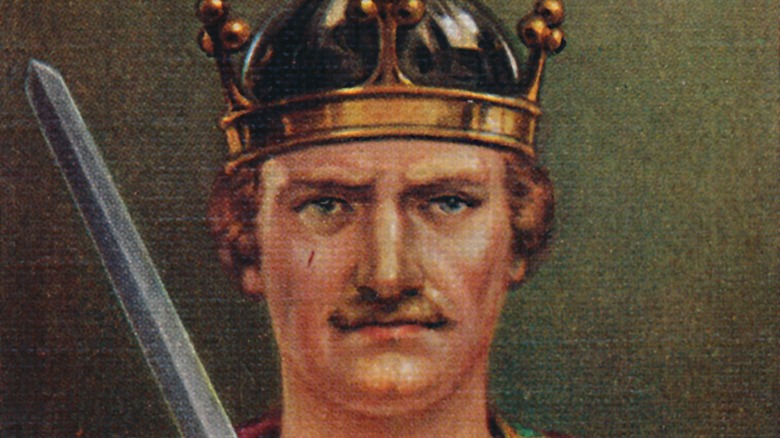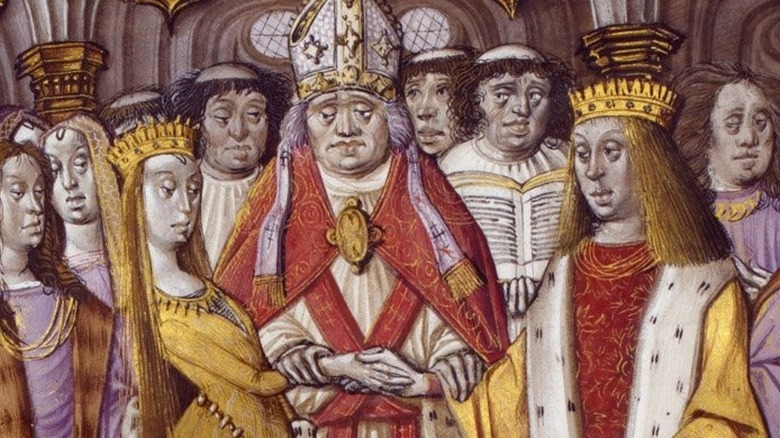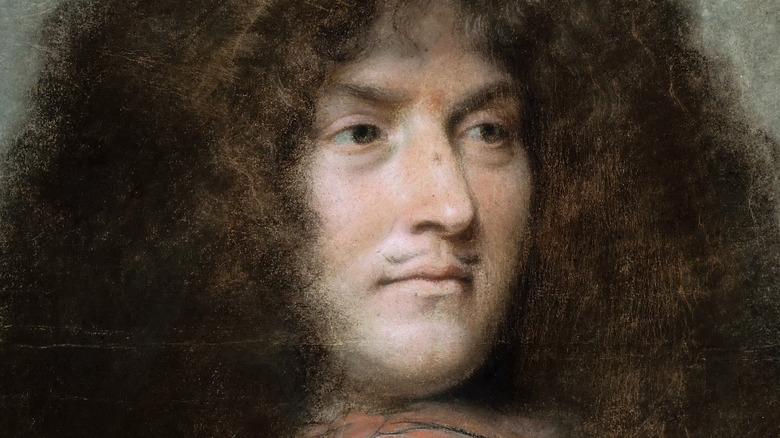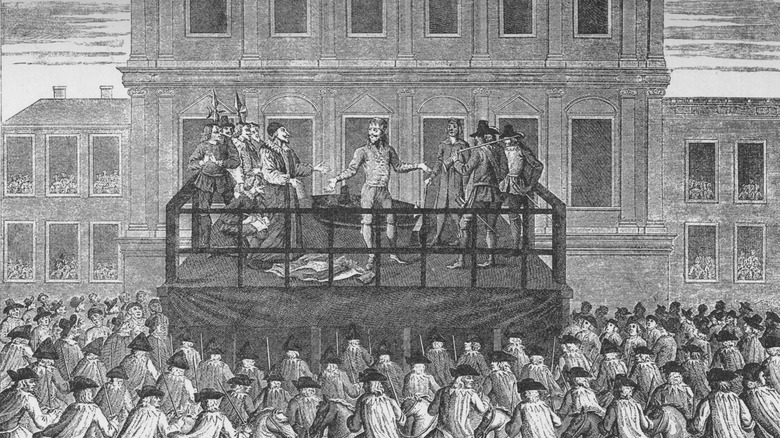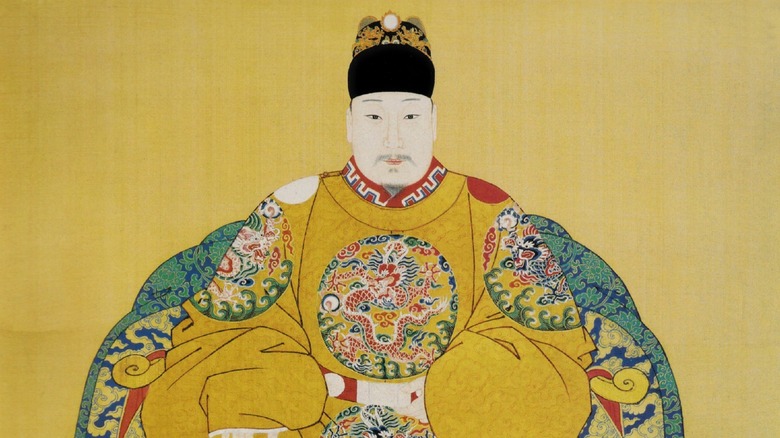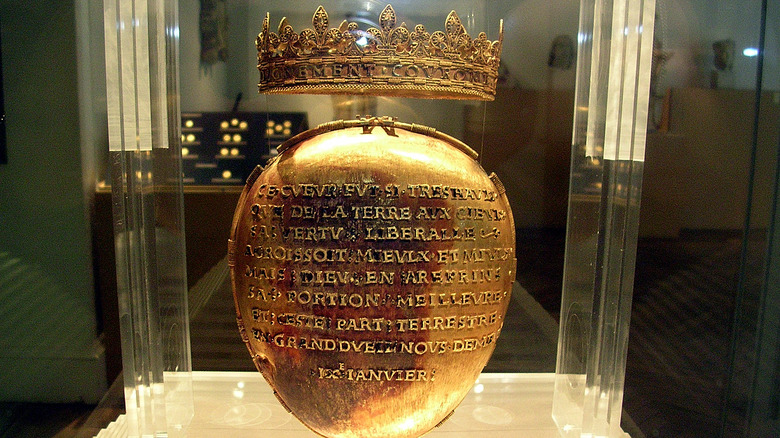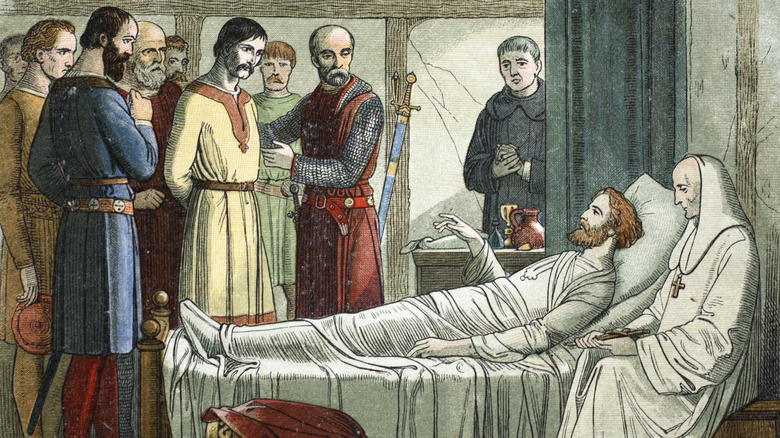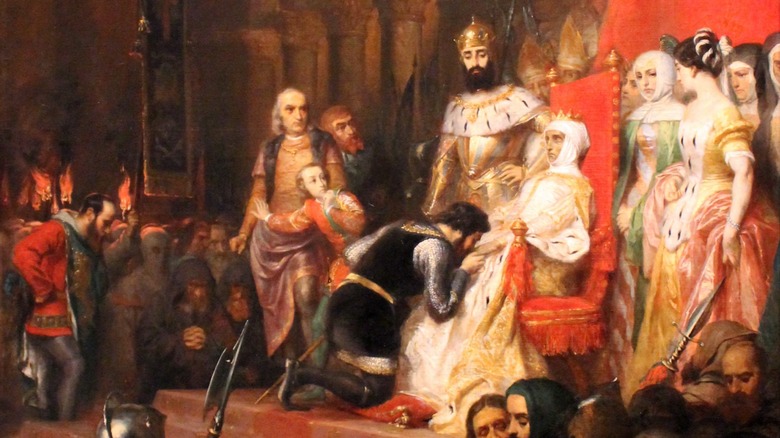The Weirdest Things That Happened To Royals' Bodies After They Died
The bodies of royals are complicated. In some cultures, royalty is – or at least was – seen as divine, making their bodies literally holy vessels. Royal women had to deal with their wombs technically being property of the state, which had a vested interest in what went in and out of their bodies. Then you have the modern phenomenon of royals being photographed constantly, and often having their bodies metaphorically ripped apart by the media and their bored subjects. With Princess Diana, for example, this resulted in tragedy. And yet, the royal body is also off limits, as anyone who tries to reach out and grab a royal who is surrounded by security would quickly learn.
The complicated issues royal bodies bring with them don't stop when the royal dies. If anything, the difficulties for those in charge of the corpse are just beginning. Many royals have been treated with the reverence they would expect in death, with elaborate funerals and rituals centering on their remains. You'd think with all their money and power, pulling off the basic task of getting a body safely in the ground and keeping it there would be easy. But sometimes, things go drastically wrong. Whether it's a terrible accident or a misunderstanding or done with planning and malice, there are plenty of ways the body of a dead member of a royal family can end up in a very unregal situation. Here are the weirdest things that happened to royals' bodies after they died.
William the Conqueror
William the Conqueror might have a cool sobriquet now, but as a kid he was known as "William the Bastard," for obvious reasons. Still, he became an aristocrat, fought about a dozen different enemies, and managed to successfully invade England, according to Mental Floss. It's enough to make anyone hungry. And William certainly was, as he ate himself to a truly remarkable size.
There's nothing wrong with being large, but in this case, it directly killed William. While off fighting more enemies in 1087, the king was stabbed in the stomach by his saddle horn and ruptured his intestines. It took him six weeks to die. You'd think that would be long enough to plan a funeral fit for a king, but instead, the second he was dead virtually everyone from the servants to the aristocrats fled, "leaving the king's body almost naked on the floor of the house ... as if he had been a barbarian," Orderic Vitalis recorded in his "Historia Ecclesiastica."
The few people who remained buried William, but at the funeral things got so much worse. As Orderic explained (via "Memory and Myths of the Norman Conquest"), "When the corpse was placed in the sarcophagus, and was forcibly doubled up because the masons had carelessly made the coffin too short and narrow, the swollen bowels burst, and an intolerable stench assailed the nostrils of the by-standers and the whole crowd. A thick smoke arose from the frankincense and other spices in the censers, but it was not strong enough to conceal the foul ignominy." Gross.
Queen Catherine of Valois
Samuel Pepys was a relatively middle-management courtier to Charles II, but his name has gone down in history because he was very, very good at writing in his diary. According to Royal Museums Greenwich, one of the few things Pepys didn't record much about in his diary was his birthdays. He kind of mentions how old he turned as an aside in those entries, and one year he doesn't even bother doing that. And there's no real hint of celebration on his birthdays either. While he does go see plays or attend a dinner or hang out with his mistress, back then those were everyday things for someone of his class.
One notable exception is the last birthday in the diary, in 1669. There was a family outing to Westminster Abbey, where they got a tour of the royal tombs. This included that of Catherine of Valois, the 15th century French wife of Henry V. The tomb was broken, and they could see her corpse exposed, "the bones being firmly united, and thinly clothed with flesh, like scrapings of tanned leather," as John Dart would write in the next century.
Then, Pepys records, he did this very odd thing: "I had the upper part of her body in my hands, and I did kiss her mouth, reflecting upon it that I did kiss a Queen, and that this was my birth-day, thirty-six years old, that I did first kiss a Queen." Well, that's certainly one way to treat yourself on your birthday.
Sabata Dalindyebo
According to the New York Times, Sabata Dalindyebo was "the paramount chief of the Themba people" who occupied an area of South Africa that was "nominally independent" from the all-white apartheid state. While that sounds kind of like a good thing, these areas were carved out by the apartheid government, and the African National Congress, as well as Chief Sabata, were extremely opposed to them. The chief was outspoken about his support of a South Africa where every person was equal. This made him a concern for the government, especially when he died in 1986. They knew his funeral would be used as a large-scale protest against apartheid.
So they stole the chief's body. Not only was the corpse stolen, but it was taken by Chief Sabata's archnemesis, whom the Los Angeles Times says he referred to as "a usurper, scoundrel, and traitor."
Winnie Mandela learned about the crime when she was preparing for the funeral and someone ran into her home and told her, "They have taken his body." The government hastily buried Chief Sabata, and the people were incensed. "What crime is more despicable than stealing a man's body from his grieving family?" the chief's son asked. "And when a chief ... is buried like a pauper, then it is a crime against the whole nation, not just against his family." Winnie Mandela said, ”It really seems even in his death the late King was a detainee. The King was virtually turned into a prisoner in his coffin.”
It wasn't until 1989 that Chief Sabata received an elaborate funeral.
Louis XIV
France's famous Louis XIV, the Sun King, died in 1715. He was buried in the traditional location for the country's royals, the basilica of St. Denis in Paris, according to "Caves, Coprolites, and Catastrophes: The Story of Pioneering Geologist and Fossil-Hunter William Buckland." But two things would make sure Louis did not rest in peace: the French Revolution, and the aforementioned William Buckland.
When anti-monarchy mobs revolted in France in 1789, one of their targets was the basilica, where the royal tombs were looted and destroyed. Westminster Abbey claims Louis XIV's heart was taken from the tomb by a member of the English aristocratic family the Harcourts. They brought it to Britain, and in the mid-1800s, the heart would have a run in with Buckland.
When an aristocratic Englishman is described as "eccentric" you know they are on another level. Buckland's main weird quirk was that he wanted to eat everything at least once, and he gave it a good ole try. (Apparently, the worst thing he ever tasted was bluebottles, per the Guardian.) Once, while teaching a class, he ran at a student with a hyena skull yelling "What rules the world?" As the student panicked, Buckland answered his own question: "The stomach, sir, rules the world!" When invited to a dinner at the Harcourt residence, Buckland was shown the family's treasure, Louis XIV's heart in a silver box. Buckland grabbed it, put it in his mouth, and swallowed it, saying, "I have eaten many strange things, but I have never eaten the heart of a king before."
Charles I
Charles I was the only English monarch to be executed. After disagreements with Parliament, which resulted in the English Civil War, Charles was put on trial and convicted of treason against his own people, according to Historia. Since treason was a death penalty crime, that meant Parliament was in the awkward and unprecedented position of executing the king.
There were legitimate worries about how this would play out. While the politicians had their reasons for not liking the king, the regular people didn't necessarily agree. The execution would take place in public, although attempts were made to keep the number of observers down a little. On January 30, 1649, Charles was led to the scaffold. He spoke to the crowd, but drummers ensured he could not be heard. Then he laid his neck on the block.
An anonymous observer recorded what happened next (via Eyewitness to History): "After a very short pause, his Majesty stretching forth his hands, the, executioner at one blow severed his head from his body; which, being held up and showed to the people, was with his body put into a coffin covered with black velvet and carried into his lodging." How would the crowd react now the horrible deed was done? It turns out ... really morbidly. "His blood was taken up by divers persons for different ends: by some as trophies of their villainy; by others as relics of a martyr." In other words, they dipped things in his blood as souvenirs.
The Wanli Emperor
Dìng Líng in China is the third-largest tomb from the Ming dynasty and, according to Lonely Planet, it's the only one that's ever been excavated from that time. Based on what happened to the royal bodies in this tomb, that's probably the way it will stay.
Atlas Obscura explains that in 1956, just seven years after Mao Zedong took power in China, some of the county's archeologists asked if they could excavate Dìng Líng. Technically, this was going to be a sort of rehearsal dig for a bigger one they had planned. But they botched it, big time. While they found amazing treasures, with the official report on the dig describing (via China Daily) "countless pieces of gold and jade jewelry and wares, and hundreds of [silk] fabric rolls." But with inadequate technology or storage facilities for these priceless things, many were quickly destroyed by the elements.
They also found royal bodies, including the Wanli Emperor, and the report said, "The flesh on the three corpses has rotted completely, but the bones remain intact, and in all three cases the hair is soft and shiny." Then came the Cultural Revolution. In 1969, members of the Red Guard took the bodies of the Wanli Emperor and his wife from the tomb, screamed at them in public, then lit them on fire. The wife of one of the original archeologists said, "A few years after that, my husband and some others went to the site where the burnings happened looking for anything that might have been left of the corpses, but with no success."
Anne of Brittany
Although Anne of Brittany only lived to be 36 years old, she still managed to become queen of France twice in that time. Mental Floss says she was originally married to Charles VIII when she was 12, and after he died she married his heir, which fortunately wasn't as gross as it could be, since Louis XII was only Charles' second cousin once removed.
When Anne died in 1514, she was buried in the traditional tomb of the French royal family at the Basilica of St. Denis but asked for her heart to lie next to her parents in Brittany. It was put in a gold case (pictured), and even managed to avoid being destroyed during the French Revolution, when anything royal the mobs could get their hands on was trashed.
So it was especially upsetting when, in 2018, thieves stole the heart from the Thomas-Dobrée museum in Nantes. People were shocked. Philippe Grosvalet, president of the group that oversees the museum, said, "The thieves attacked our common heritage and stole an item of inestimable value. Much more than a symbol, the case containing the heart of Anne of Brittany belongs to our history." He asked them to come to their senses: "If the thieves were motivated by the fact that it is shiny and made of gold, they should understand that its historical and symbolic value far outweighs its 100 grams of gold."
The BBC reports that thankfully the heart was found, safe and intact, a month later.
Philip the Handsome
When you go down in history as Philip the Handsome, you know you've done well for yourself. Philip, Duke of Burgundy married Joanna of Castile in 1496. But he cheated on his wife constantly. This made her jealous and unhappy, and then Philip died. This didn't stop Joanna's obsessive love for her husband, and one historian at the Spanish court at the time said she suffered from "the same jealousy that tormented her during her husband's life." Esquire says that she would take his coffin with her everywhere, even eating next to it at dinner. A chronicler recorded that she would visit her husband's body every day, kissing the corpse's feet, driven "to the point of love madness ... the Good Queen had no more profit or repose than a woman damned or deranged."
This is the old-school way of looking at what happened to Joanna, which earned her the sobriquet "Juana la Loca" or "Joanna the Mad." The men around her wrote down how she'd completely cracked, the poor weak lady who couldn't handle her husband's death and did gross stuff with his corpse.
But revisionist historians are taking another look. People, including her own father, were always trying to overthrow Joanna, and by keeping her husband's body near her, she may have been using it as symbol, both of her power and the legitimacy and rights of her children, according to "Juana of Castile: History and Myth of the Mad Queen." Rather than unable to deal with her loss, she might have been defending her throne, using the corpse as a weapon.
Torgbui Hor II
The weird thing that happened to Agbozume Chief Torgbui Hor II's body after he died was ... nothing. Nothing at all, meaning it lay in the morgue and was not buried for a long, long, long time. In fact, it's not clear if he has ever been buried. Why? Because the chief's family can't decide who should be chief mourner at his funeral.
Lest you think this is just cultural differences, Ghanaian journalist Elizabeth Ohene wrote an article for the BBC in 2018 expressing her frustration with this case. While she says that it's not unheard of in Ghana for funerals to be delayed while the chief mourner issue is worked out, by that point Torgbui had been dead for 6 years. Ohene explains that the issue is the family has to decide on the chief mourner, writing, "You would think you know what and who constitute family, but once there is a death, the definition of family changes completely. A spouse and children suddenly do not qualify as family once there is a death." Instead, it's the large extended family of the deceased who decide, which causes issues: "This 'family' and this chief mourner might not have seen or spoken for the past 30 years with the dearly departed, but they are deemed to know more about the dead person than the spouse and the children."
Citi Newsroom reported in 2018 that after the funeral was delayed yet again due to a high court injunction, the unresolved feud over the chief's body was becoming a "threat to security" of the local area.
Richard I
Richard I, a.k.a. Richard the Lionheart, is famous for being king of England, probably because of his mentions in the Robin Hood tales. But in reality, Richard wasn't in England all that much. He had land in France he liked, plus he was always off fighting one Crusade or another. But it was while combining those two loves and fighting some enemies in France that he was shot with a crossbow bolt and died.
Sometimes, important people in the Middle Ages would have their heart buried separately from their body. According to the BBC, Richard actually had three bits of his body buried in completely different locations ... but despite this, they were all in France. Couldn't even spare a pinky toe for poor England. Richard's body is in Fontevraud Abbey, his "entrails" went to Chalus, and his heart was taken to the cathedral of (not that) Notre Dame in Rouen.
Over 800 years after Richard died in 1199, scientists analyzed his heart and found it had been embalmed using ingredients that, as the Daily Beast notes, would have cost a pretty penny. Dr Philippe Charlier explained, "The spices and vegetables used for the embalming process were directly inspired by the ones used for the embalming of Christ. For example, we found frankincense. This is the only case known of using frankincense ... That consciousness of using very high-quality herbs and spices and other materials that are much sought after and rare does add to that sense of it being Christ-like in its quality."
Inês de Castro
The 16th century Portuguese poet Luís Vaz de Camões called Inês de Castro the one "who after being killed was queen" (via Portugal Things). In the 1400s, Pedro, the heir to the Portuguese throne, met Inês and fell madly in love, but his dad King Afonso IV made him marry someone else. But Pedro refused to stop seeing Inês, having kids with both her and his wife. To solve this problem, the king had Inês killed.
After Pedro inherited the throne, he wanted his children with Inês and not his wife to be his heirs, so he claimed that he and Ines secretly got hitched before he was married the official time. This would make him a bigamist, but he was king, so everyone let it go. Regardless, Pedro used his claim to make his kids legitimate, which meant Inês had been the real queen the whole time.
Now, the rest of this is just legend, and didn't appear in any records until the 1500s, according to Google Arts and Culture. It's said that Pedro dug up Inês, sat her on the throne, and made the whole court kiss the hem of her skirt as a sign of fealty to her. Other sources, like the Encyclopedia Britannica, say a crown was placed on her head and courtiers had to kiss her hand. While it's probably apocryphal, if any part of it is true, it's definitely one of the weirdest things ever done to a royal after they died.

